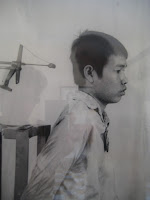 |
The morning was normal (shower, breakfast, hired 2 motorbikes to drive us there). But when we got there, how can I describe it.
It was very hot, at least 80 degrees with the sun beating down on us. There's a front gate and then a field with a few buildings around, a few trees and a giant stupah/pagoda. We walked into the grounds with our guide who took us immediately to the stupah. It's easy to see even from a distance that it's full of skulls. The front is glass and there are 17 tiers and the tiers are full of bones excavated from the shallow graves and at least 5 of the lower tiers are full of skulls.
Over 20,000 people were killed at that site alone - the Khmer Rouge killing 1.7 million in total, over 20% of the population, through forced labor, malnutrition, poor medical care and executions. Twenty thousand people in five years and the site wasn't that large. People were brought in with their hands tied behind their backs, blind folded and killed though rarely with bullets because bullets were too valuable. They used what they had - hammers, axes and in the case of the babies, they just smashed them against a tree. The people often came from the site known as S-21, a former school turned torture camp in Phnom Penh. Intellectuals, old people, women, children, babies killed. And this site was just one of many around the whole country.
Our guide, a gentle man of 53 who lived through it all, lost most of his family to the KR. He didn't talk too much, mostly repeated what was on the signs, but he'd often scrunch up his eyes and say things like, "Crazy man," as the only way to comprehend Pol Pot or he'd say, "Too bad!" He was very kind to me as I was having a really hard time getting through it. I didn't close myself off enough, and the raw pain, horror and sadness saturating the place got the better of me.
 |
| We forgot to take photos. This is the best we have of our guide. |
It's impossible to see something like that and not get trapped in "why". There isn't an answer, though. There are ways to rationalize and things that were said to justify, but when it comes down to it, I do not believe there is an answer to why genocide. I decided not to try, decided to let go of the thinking around it. I said prayers and lit incense for the spirits still there. I tipped the guide well to honor his survival and the memory of his family. I recommitted to the love and compassion in my heart as my motivation for moving through this world.
 |
| Our guide told us to stand by the palm tree, asked for our camera and took this photo of us. |
Outside the site we sat with our drivers and a few locals. I asked what happened to the men who did the actual killing. It took a while for them to even understand the question. They kept answering about the leaders, the men in charge. They finally understood who I was asking about and the older local man said that one of the men who worked there was still living in the area. I was shocked and imagined that people would at the very least have made him leave to another place. But they explained that the people in charge hired boys of 15-18 to work there and that boys that age are easy to train to not care. They said that if the people brought in to do that work didn't do it then they'd be killed and someone else would then come in. They didn't seem to have any ill feelings to the men/boys who held the hammers. Extraordinary.
 |
| S-21 view from first building |
After that we went to S-21 to see the torture compound. No guide this time. Lots of tourists, a few school groups. The things that happened there - horrible. The KR kept records much like the Nazis did so there are thousands of photographs of the people they killed. The place felt haunted. I kept trying to think that what I was looking at was from long ago, but it is from my lifetime.
 |
 |
Looking at the teenagers goofing around, people filling the restaurants, motorbikes zooming everywhere it's hard to imagine this town almost totally empty. It's hard to imagine a Cambodia choking in the grip of Pol Pot and the Khmer Rouge. But that is not what's now and Cambodia marches on.





That was an intensive abuse of our emotions. I think it was necessary to go but it's one tourist attraction to which "enjoy" is impossible to attach. I hope to never again endure something as perverse as being asked to pose beneath a tree by which prisoners' throats had been slit. We both learned a lot from it so that's valuable, but it's a hard-won lesson.
ReplyDelete